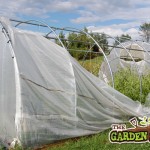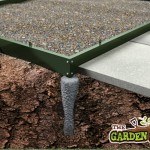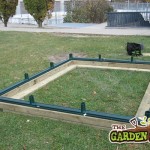I woke up this morning to the all too familiar sight of my greenhouse lying face down on the back lawn. Its contents are no doubt heaped up in one great big mess inside. An array of plant pots, compost, seed trays, matting, hand tools and other objects all lie in wait of rescue. Of course on a windy Monday morning I could bring myself to survey the damage – that will be left to this evening.
- Damaged Greenhouse
- Anchor Pins
- Timber Base
It’s the 3rd time over the last year that my greenhouse has blown over. At least this time it happened before I started sowing seeds so there were little more than empty plant pots and some hardy herbs sitting out the winter months inside. Of course if the greenhouse blows over anytime between late February and September the consequences would be much greater.
There is no sadder sight than a muddled heap of compost and young seedlings strewn across the garden lawn – all that hard work and weeks of growth gone down the pan. Generally when the greenhouse blows over there is little that can be saved – and generally those that do make it are often only a shadow of their former selves.
So, on this; the third occasion I truly only have myself to blame as by now I should have securely anchored the thing down. So, with that, I thought I would go through all the best options for securing your greenhouse with the hope of preventing this tragedy from happening again.
Whether your greenhouse is plastic, glass or polyethylene you will need to secure it as they are both lightweight and ‘Sail-like’. This is a bad combination. I first secured my greenhouse down with block-paving blocks. I allowed the extended flaps of the greenhouse cover to hang down and I placed about 20 or so blocks along this. This method was both neat and sufficient for the best part of the year. But last night we had winds of up to 45km / hour and this was enough to undo my makeshift anchoring.
So a more secure option would be needed.
Using Timber
Best to use heavy timber posts; you can use old railway sleepers, 4” x 8” timber sections, or old scaffolding posts to form the new base for the greenhouse. These should be screwed into a solid base – ideally a concrete base. The greenhouse can then be fixed to the timber base again using screws.
The other advance of this is that you can even raise the height of the greenhouse, which is something that most taller gardeners would need to avoid having to bend whilst attending their plants.
Set in Foundations
As stated a concrete foundation is best when securing a greenhouse, it provides a solid base, ensures the greenhouse is level, prevents grass and weed growth and allows for a more secure fixing of the greenhouse. To secure your greenhouse to a solid base position the greenhouse and pour additional cement around the base allowing setting and securing the greenhouse.
Pins & Anchors
If your greenhouse is on soft ground such as a lawn or soil then you can pin it down using long anchor pins. These would need to be at least 50cm in length and would need to be placed around every possible spot on the base. For smaller greenhouses you can dig a trench around the base, place the additional polythene cover in to the trench and back fill. The weight of the soil can be sufficient to hold the greenhouse down


